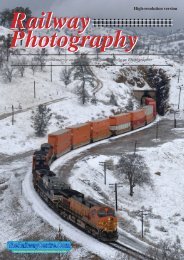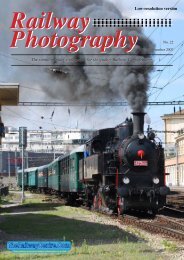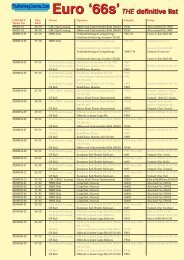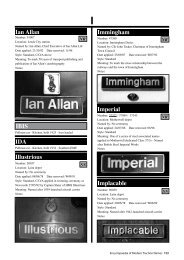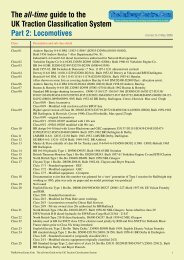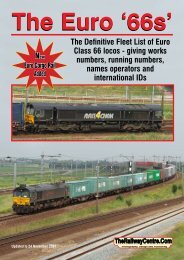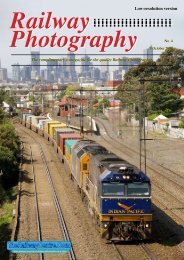Download High Resolution file 7mb - The Railway Centre.Com
Download High Resolution file 7mb - The Railway Centre.Com
Download High Resolution file 7mb - The Railway Centre.Com
- No tags were found...
Create successful ePaper yourself
Turn your PDF publications into a flip-book with our unique Google optimized e-Paper software.
<strong>The</strong> Port of Los Angeles Waterfront ‘Red Car Line’ operates two replica Pacific Electric 500-class cars built ata Port of LA facility in Wilmington, California. <strong>The</strong> replica 500s are a compromise between the original designand requirements for a modern heritage trolley operating in an urban environment. <strong>The</strong> new cars feature awelded steel frame carrying a wooden superstructure that accurately replicates the appearance of a PE 500-class suburban car of 1920. Vintage running gear was obtained from the Seashore Trolley Museum and rebuiltwith new wheels and refurbished motors. <strong>The</strong> cars seat 48 passengers, and are equipped for both high leveland ground level boarding. As on the original cars, a traditional ‘California Type’ open-air section has beenincorporated, complete with heavy canvas curtains that can be pulled down during inclement weather. CarNo. 500 is seen at the mid-stop on the short LA Port line on 24 September 2007. Colin J. MarsdenPhotographic details: Camera: Nikon D200, Lens: Nikon 24-70mm zoom @ 29mm, ISO: 200, Exposure:1/1000 at f5.6<strong>Railway</strong> Photography3
<strong>The</strong> Tay Bridge at Dundee is one of the wonders of rail engineering in the UK. To show its full size is quite difficult in photography, but with a little thought and the useof a different perspective, some spectacular images can be obtained. Our photographer here has gone on a walkabout and found this view looking down on the structure.It shows a panoramic view of the 14.00 London King’s Cross to Aberdeen dropping down into Dundee about five minutes before the sun set behind the hills on 20August 2007. John ThompsonPhotographic details: Camera: Nikon D50, Lens: Sigma zoom @ 95mm, ISO: 200, Exposure: 1/160sec at f5.64<strong>Railway</strong> Photography
STORING theimageOne of the most frequently askedquestions I receive about digitalphotography is how do I store my imagesand take as much precaution as possibleagainst loss or damage.<strong>The</strong>se are two very important topics anda feature we should have looked at earlier.In terms of storage, as soon as I return tomy office after a photo shoot, I downloadthe images, using a FireWire card reader.I create a folder on my desktop identifiedby date (ie 25/09/07), all the imagesare placed here. As soon as possible Irenumber each image <strong>file</strong>, the system I useis the date (ie 250907), followed by a dash(-) and the frame number, this will start 001upwards. Thus I am left with image <strong>file</strong>snumbered for example 250907-001, theseare suffixed either .JPG or .NEF, to keepthe <strong>file</strong>s separate I move all the NEF (raw)<strong>file</strong>s into a separate folder within the dayspicture <strong>file</strong>. This way it is easier to reviewthe jpg <strong>file</strong>s quickly via an automated slideshow, then to select the NEF <strong>file</strong> if needed.To avoid taking up huge amounts ofspace on my computers hard drive, I havea bank of stand alone Fire Wire connectedhard drives onto which I write the image<strong>file</strong>s, in addition I burn the days work ontoa DVD and store it away from the mainoffice.As hard drives can crash at anytime, Irenew the image <strong>file</strong> hard drives everycouple of years or so. This might sound alittle wasteful, but if considered alongsidethe possible loss of a huge number ofunrepeatable images, it is a small cost.Different people have differentapproaches to editing images. I tend toonly edit the material I need. This policywas adopted from an early time in theworld of digital photography after Ifound that an image edited today andconsidered good and perhaps could not bebettered, could be vastly improved withthe release of new software in just a fewmonth. Editing every kept image as soonas it is taken to me wastes a lot of time andfrankly a new edit for each use is the bestoption.Captioning images using Photoshopor other image handling software andsaving the data in ‘File Data’ is very useful,however, I keep a full database of everyimage taken, logged against the individualimage number in an Excel database. I havefields for <strong>file</strong> number, loco/train number,exposure date, location and description.<strong>The</strong>se can then be sorted by any or amultiple of parameters to provide a reportof the images you are seeking.<strong>The</strong> one thing I will always recommendis that you keep your original exposed<strong>file</strong> safe and well and only use and editcopies. We still hear of people who are soexited about seeing their new pictures thatthey open and edit original <strong>file</strong>s withoutkeeping any back ups.Please do not do this, always work witha back up. nTelephone Photography<strong>The</strong> days of publishing pictures taken on mobiletelephones is now with us, especially in terms of webpages. Modern c-mos sensor cameras are now emergingwith camera resolution of around 5mp and these arequite good enough for screen reproduction at say 800pixwide.In terms of paper reproduction you still have to bevery careful, even using a top end mobile telephonesuch as the Nokia N95 fitted with a 5 mp camera anda Carl Zeiss 2.8-5.6 autofocus lens the quality is onlyjust good enough for printing. This is mainly due to thelens quality of the camera. However that said once ortwice recently TRC have used telephone images and theresults with careful digital darkroom work have beenvery successful.<strong>The</strong> Nokia N95 produces an image of 2592 x 1944pix with a size 21.95cm wide at 300dpi. <strong>The</strong> imagereproduced below was edited in Photoshop CS3, witha little brightening all over, slight dodging of the frontend area, the entire image was then given a very smallamount of ‘Shadow & <strong>High</strong>light’ around 3% in Shadowand 0 in highlight, finally 6% of ‘Smart Sharpening’ wasapplied.<strong>The</strong> resultant image was then used as a print trialand the image quality was sufficiently good for normalmagazine reproduction.When taking this image the camera was used at justa small amount off the base wide angle setting, withtrimming performed on the computer. Tests undertakenby TRC found that as soon as any form of zoom wasperformed the quality dropped off drastically.We would not suggest that any photographer throwaway his prime Nikon or Canon in favour of a qualitydigital equipped telephone, but if you are out and aboutwithout your prime camera you might get away withthat important news story.<strong>The</strong> present phone results are on par with the low-endcompact digitals of about five years ago - just look howfar this technology has come and I have no doubt that inthe long term phone camera will be used in every daypicture taking and publication work.CJM<strong>Railway</strong> Photography 5
Above: Lets just hope Mother hasn’t got the washing out! <strong>The</strong> dust blow down from aggregate trains, especially along the Berks and Hants main line issomething of a major problem for the local inhabitants, however in terms of photography it adds another dimension to the picture. On 7 September 2007, EWSNo. 66083 powers the 10.15 Whatley Quarry to St. Pancras formed of the original National Power hoppers near Aldermaston. Ken BruntPhotographic details: Not supplied<strong>Railway</strong> Pictorial<strong>Railway</strong> Photography looks forward to receiving yourpictures for inclusion in these pages, please sendhigh-resolution images to RP@therailwaycentre.com andshare your work with others.Below: We often hear and read comments about the growth of weeds and lineside vegetation in the UK, but by the look of this view at Ludwigsburg our friendsin Germany may have an even more serious problem! <strong>The</strong> picture, taken on 17 August 2007 shows DB Regio Class 140 set No. 140 345-0, a 4-car articulatedtrain set built by Siemens. Maurits VinkPhotographic details: Camera: Canon 350D, Len: Canon zoom at 34mm, ISO: 400, Exposure: 1/640 @ f106<strong>Railway</strong> Photography
Above: Looking as superb as ever ex-LMS No 6233 Duchess of Sutherland rounds the curve towards Kirkham Signal Box on Wednesday 29 August 2007 poweringthe Evening Scarborough Spa Express which it only worked York to Scarborough and return after an earlier scrape of a bridge near Harrogate and working in place ofNo. 45231 which the previous day suffered cylinder damage at Church Fenton. This picture benefits from a brief moment of sunshine on the train in this very pleasinglocation with just a small amount of smoke, shows the beautiful North Yorkshire landscape at its best. Robin PatrickPhotographic details: Camera: Fuji S9500, 28-300mm zoom at 50mm, ISO: 200, Exposure: 1/500sec @ f4.5Below: It is very rare to record Class 91s piloting HST sets, firstly due to the small number of Class 91s in service, and secondly the excellent availability of the EastCoast HST fleet. However on 13 September 2007 No. 91109 was captured ‘dragging’ an HST formed with powercar Nos. 43110 and 43306 on a London King’s Crossto Edinburgh service near Colton, south of York. Excellent shutter timing has caught the ‘91’ clear of the overhead power masts. Mike SargentPhotographic details: Camera: Canon 350D, Lens: Canon 28-135mm zoom at 33mm, ISO: 400, Exposure: 1/400sec @ f58<strong>Railway</strong> Photography
Above: Reports are that visitor numbers to the ‘quality’ preserved railways in the UK is up on previous years. On August Bank Holiday 27 August 2007, preservedWest Country class 4-6-2 No. 34028 Eddystone is seen approaching Horsted Keynes leading the 15.00 Sheffield Park to Kingscote on the Bluebell <strong>Railway</strong> inSussex. It is nice to see a train of correctly liveried stock behind the loco. With the sun slightly off the front, it is all too easy to have the entire front go black. Here thephotographer has used exposure and editing tools to retain all the front detail. Michael J. CollinsPhotographic details: Camera: Canon EOS 20D, Lens: Canon zoom at 40mm, ISO: 200, Exposure: 1/400sec @ f7.1Below: <strong>The</strong>y say we have some colourful trains in the UK, but our friends in California USA can not say this train is ‘dull’. Photographed arriving empty at LosAngeles Union station on 24 September 2007, this is a Metrolink set led by driving trailer No. 6108. This set together with loco No. 901 were hired by Sound Transit(Sounder) of Seattle, Washington to Metrolink in September 2004 to cover a shortage of stock. <strong>The</strong> set is usually used on the St Bernardino/Oceanside services. LosAngeles Union station is quite railfan friendly, the photographer had no problem with security staff on three recent visits. On one occasion a member of a privatesecurity firm stopped for a chat and when he found out I was a railfan he could not have been more helpful, even offering to go and get me a cool drink on a hot day.Colin J. MarsdenPhotographic details: Camera: Nikon D200, Lens: 28-70mm zoom at 40mm, ISO: 200, Exposure: 1/1000sec @ f5.6<strong>Railway</strong> Photography 9
Above: A truly excellent piece of photographic work, showing West Coast <strong>Railway</strong> Co (WCRC) Class 57 No. 57601 with an inspection saloon passing HelwithBridge on the Settle & Carlisle line during a Network Rail inspection of lines in the North West. Our photographer said “This is actually two exposures mergedtogether in the digital darkroom, one exposure was focused on the sign and one on the train in order to maintain the maximum focus in both parts of the picture.Mark BeartonPhotographic details: Camera: Canon EOS 20D, Lens: Canon 24-70 zoom at 30mm, ISO: 200, Exposure: 1/1000sec @ f7.1Below: Short trains are often a major problem to photograph to make the finished image as impressive as the subject when originally seen. One answer is to frame thesubject with a lineside structure, such as a station, signal or pleasing item of lineside furniture. Here the photographer has made excellent use of the semaphore homesignal at Hall Dene. <strong>The</strong> train, formed of just one flask wagon is 6E44, the 07.44 (FO) Carlisle to Seaton, which on 14 September 2007 was powered by Class 20s Nos.20308 and 20311. Ken ShortPhotographic details: Camera: Nikon D200, Lens: Nikon 18-70mm zoom at 18mm ISO: 320, Exposure: 1/1000sec @ f810<strong>Railway</strong> Photography
Above: A Class 1116 banked by a Class 1144 climb away from Braz in Austria on 13 September 2007 forming the 12.46 Bregenz to Wien service. This excellentphotographic viewpoint cannot have been easy to find, or indeed reach, however the view, composition and subject make for an excellent illustration. Phil CotterillPhotographic details: Camera: Ricoh Caplio R4 <strong>Com</strong>pact, ISO: 100, Exposure: not recorded @ f4.6.Below: With the photographer starting to fight against the shadows at Seaham, one of the two pioneering five-door Class 66/9s No. 66952 powers train 6M25, the14.19Seaham to Earles powdered cement empties on 2 October 2007. In conditions of such contrast, if the photographer has the benefits of Adobe CS2 or Cs3, a littleand careful use of the Shadow/<strong>High</strong>light tool can increase the detail in the shadow area and improve the image. Ken ShortPhotographic details: Camera: Nikon D200, Lens: Nikon 18-70mm zoom at 62mm ISO: 400, Exposure: 1/1000sec @ f5.6<strong>Railway</strong> Photography 11
Above: Former Network South East ‘Network Express Turbo’, No. 166215 now painted in full First Great Western ‘dynamic lines’-livery passes non stop throughHanwell & Elthorne station on 28 August 2007. This is a truly delightful Great Western <strong>Railway</strong> station dating from 1875-77 and has been given Grade II listedstatus. <strong>The</strong> sign to the right of the unit politely reads; “Passengers are requested to cross the line by the subway”. Class 166’s can be found on express services such asPaddington to Oxford.Photographic details: Camera: Canon EOS30D, Lens: Canon EF50mm, ISO: 250, Exposure: 1/1250sec @ f7.1 Raw to Jpg then various adjustments inPhotoshopFIRST in Western SuburbiaPictures by Richard StilesBelow: <strong>The</strong> weather in June 2007 seemed to be setting the scene for the remainder of Summer dark cloud and little sun!. Under a stormy sky and a very lucky patch ofsunshine, Class 165/1 No. 165122 rounds the curve at West Ealing shortly before joining the main line, forming the 13.53 Greenford to Paddington service. On the left isthe Plasser ‘On Track Plant’ assembly and maintenance facility. West Ealing yard is a shadow of its former self and is now simply a loop for freight. <strong>The</strong>se days this bridgeis only suitable to capture trains on the Greenford branch, as electrification of the main lines has made photography very difficult.Photographic details: Camera: Canon EOS30D, Lens: Canon EF24-70mm USM zoom at 24mm, ISO: 320, Exposure: 1/2500sec @ f5.6 Raw to Jpg thenvarious adjustments in Photoshop12<strong>Railway</strong> Photography
Above: Captioned by the photographer as ‘Summer’s here!’it looks like the mother of all storms is about to break. <strong>The</strong>photographer adds, “Other than sharpening no adjustmentswere made to the raw <strong>file</strong> during processing and the surrealeffect shown is genuine”. It was created by bright warmsunshine combined with a heavy storm cloud as a back drop.Local newspapers reported hail storms hit the Clapham area,and these clouds were probably heading that way. Two-car Class165 No. 165131 is working train 2G52, the 17.55 Paddington toGreenford and is passing Acton Yard on 3 July 2007. Note theClass 66 and 59 in the yard.Photographic details: Camera: Canon EOS30D, Lens:Canon EF50mm, ISO: 200, Exposure: 1/1600sec @ f5.6 Rawto JpgRight: <strong>The</strong> same Turbo as seen above, No. 165131 is illustratedagain, this time working train 2G31, the 12.53 Greenford toPaddington service at Ealing Broadway on 7August 2007.<strong>The</strong> tall office block has been a feature of the station for manyyears and photographers using a 50mm lens have a ‘trade off’between including all of the building and giving the train lessprominence, or concentrating on the train and cutting thebuilding in half. Ealing Broadway was once the terminatingpoint for the Greenford shuttles, but these now run through toLondon. Of note are the last few remaining silver D78 stock carson London Underground metals, operating on the District Linewhich serve the station providing a West London link betweenthe National Network and the LUL system.Photographic details: Camera: Canon EOS30D, Lens:Canon EF50mm, ISO: 200, Exposure: 1/2500sec @ f5.6 Rawto Jpg<strong>Railway</strong> Photography 13
Above: <strong>The</strong> San Francisco ‘F’ Line uses a number of historic cars for daytime fine weather operation. Here San Francisco car No. 130. built in 1914 andstill in frequent use, rounds the very tight curve into Steuart Street. At this point on the vintage cars the conductor has to manually change the contactpole onto the correct wire. <strong>The</strong> vintage cars tend to operate between 10.00 and 18.00 and frequently only on the Fishermans Wharf to 8th Street section.Photographic details: Camera: Nikon D200, Lens: Nikon 24-70 zoom at 60mm, ISO: 320, Exposure: 1/750sec @ f5.6Below: Port of Los Angeles Waterfront ‘Red Car Line’ replica Pacific Electric 500-class car No. 500 is seen at the Ocean Liner station in the Port of LosAngeles. <strong>The</strong> line’s two replica cars feature welded steel frames carrying a wooden superstructure and replicate the 1920s vehicles ot the original line. Eachcar seats 48 passengers and provides an excellent ride along the harbour front, plans exist to extend the system, but the present operation is a delight to seeand ride.Photographic details: Camera: Nikon D200, Nikon 17-24 zoom at 22mm, ISO: 200, Exposure: 1/1000sec @ f5.6<strong>Railway</strong> Photography 15
Left: We just have to hope that these‘chaps’ understand the red crossinglights and have attended one on NetworkRails ‘Crossing Safety’ lectures, as thegoatherd appears to be showing littleinterest as to whether his flock havecrossed the line. This amazing picturewas captured at Cieza in Spain on 2March 2007. Phil CotterillPhotographic details: Camera:Ricoh Caplio R4 <strong>Com</strong>pact, ISO: 100,Exposure: not recorded @ f7.4Below: This could be captioned ‘Whatto do with a light loco’ It is often hard toknow how to place light locos especiallyin the landscape. Here our photographerhas done an excellent job of placing thelocos in a perfect position by the side ofthe moored yacht. <strong>The</strong> view was takenof DRS No. 47802 on Kent Viaduct inCumbria on 4 September 2007.Nathan WilliamsonPhotographic details: Camera:Canon 300D, Lens: Canon zoom at55mm, ISO: 200,Exposure: 1/500sec @ f9From a different viewpoint........16<strong>Railway</strong> Photography
Above: A real picture from a different viewpoint, described by the photographer as “A most rewarding working” it depicts DRS Class 37 No. 37069 heading train 1Z20 13.50London Paddington to Derby RTC Serco test train passing over the split Rivers of the Tame and Trent at Wychnor viaduct, near to Alrewas between Burton-upon-Trent andTamworth high level on Friday 7 September 2007. <strong>The</strong> image was filtered to provide this stunning effect. Phil GrainPhotographic details: Camera: Mamiya 645 pro TL, Lens: Mamiya 55-110 zoom at 90mm, Film: Fuji Provia 400X, Exposure: 1/1000sec @ f16. Filters: LEENeutral density 0.9 hard grad (over sun/sky), mahogany, sunset OrangeBelow: Good reaction time on the part of the photographer here to capture this First TransPennine Express Class 185 No. 185111 emerging from behind a tree andpressing the shutter button at just the correct moment as it passes Grange-over-Sands on 4 September 2007. Nathan WilliamsonPhotographic details: Camera: Canon 300D, Lens: Canon zoom at 22mm, ISO: 100, Exposure: 1/1250sec @ f3.5<strong>Railway</strong> Photography 17
This is the view from the station footbridge at Harrow and Wealdstone, looking northat 21.30 on the evening of 18 July 2007. <strong>The</strong> photographer said “It is not a place I wouldrecommend hanging around too long at night though” however his effort has worked verywell. Congratulations on seeing a different view. Richard StilesPhotographic details: Camera: Canon EOS30D, Lens: Canon EF50mm, ISO: 500,Exposure: 1/500sec @ f3.2 Raw to Jpg then various adjustments in Photoshop (<strong>The</strong>photographer removed some lights, bright spots and darkened some areas lightly)



